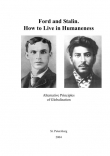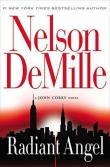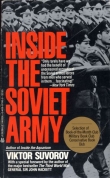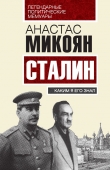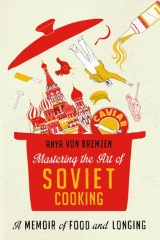
Текст книги "Mastering the Art of Soviet Cooking"
Автор книги: Anya von Bremzen
Жанры:
Биографии и мемуары
,сообщить о нарушении
Текущая страница: 19 (всего у книги 23 страниц)
Between 1992 and 1999, Yeltsin’s dermokratiya (crapocracy) sent Russia into free-market shock. Rampaging inflation, pitiful salaries unpaid—the previous hungry years of sauerkraut were remembered as plentiful. Overnight, a giant sleazy fire sale of national resources spawned oligarchs out of former apparatchiks and gangsters. Lesser beings lost everything: identity, pride, savings, Crimean beaches, and the comforting rhetoric of imperialist prestige and power. Not to mention the Soviet state’s social benefits. What’s more, Boris “Champion of Sovereignty” Yeltsin started a war to stop Chechnya from seceding, a conflict with horrors that fester to this day.
In 2000 an obscure midget with a boring KGB past was elected post-Union Russia’s second president and started flexing his muscles. Authoritarian symbols and rhetoric were revived. Among them, the Soviet national anthem—the words “Russia–our sacred power” substituted for “unbreakable Union of Soviet Republics.” Under Putin’s petrodollar kleptocracy, narcissistic consumerism began to bloom and boom. Money and glamour—Russified as glamur—swaggered in as the new state ideology (fretfully decried by the intelligentsia). These days Muscovites still order Georgian kharcho soup and Ukrainian vareniki dumplings at cute “ethnic” restaurants. But mostly they enjoy carpaccio and sushi—at oligarch prices.
Recently, cleaning my office in Queens, I unearthed a box of recipe postcards from the seventies. Fifteen sets, each celebrating a Soviet republic’s cuisine. Arranging them slowly on my dining table, I recalled the rain-washed autumn day four decades before when I scored these defitsit treasures at the big Dom Knigi bookstore and triumphantly carried them home. Poring now over the faded Technicolor close-ups of Moscow-designated “national dishes,” I still twinged at their faintly fragrant Orientalist spell, their enticements to wanderlust. There was “Azerbaijani” sturgeon salad, inexplicably smothered in Slavic sour cream, pictured against socialist oil derricks rising from the blue Caspian Sea. Faux “Kyrgyz” cakes, exotically called “Karagat” though featuring black currants in no way native to arid Kyrgyzstan. Umpteen ethnic variations on salat Olivier and kotleti. National in form, socialist in flavor, exactly as the Party prescribed.
Why was it, then? Why, of all the totalitarian myths, had the gilded fairy tale of the friendship of nations stayed so deeply, so intimately lodged in my psyche?
Fearing the answer might expose my inner Soviet imperialist, I quit speculating. Instead I decided to throw a birthday dinner for Mom featuring the real dishes of our erstwhile republics. As celebration, as semi-expiation.
For a solid week I pulverized walnuts for Georgian chicken satsivi, folded grape leaves around scented Armenian lamb, fried pork crackling for my bonafide Ukrainian borscht. Proudly I set these out on Mom’s birthday table along with Moldovan feta strudels and abysta, that bland Abkhazian corn mush of my farewell to the USSR. For dessert, a dense Lithuanian honey cake. And in tribute to the toasts at the dissolution of the Union Treaty, I even steeped a Byelorussian herbal vodka.
Mom was touched almost to tears by my handiwork. But she just couldn’t help being herself.
“Za druzhbu narodov—To the friendship of nations!” She offered the dog-eared toast with a grin so sarcastic, it practically withered my edible panorama of the republics.
“Imagine!” she exclaimed to her guests. “The daughter I raised on Tolstoy and Beethoven—she went gaga over the stupid gilded fountain at VDNKh!”
I was a little hurt by her words, I have to admit.
That Friendship of Nations fountain, by the way, has been freshly regilded in Moscow. Kids with their grandmas still circle around it. “Babushka, Babushka, tell us what it was like to live in the USSR?” the kids want to know.
“Well, once upon a time…” begin the babushkas.
CHAPTER TEN

TWENTY-FIRST CENTURY: PUTIN ON THE RITZ
We landed in Moscow on Good Friday, 2011—my mom, Barry, and I.
For the very first time ever, relatives weren’t there to embrace us at the airport. They still loved us, they claimed, but life now was different. Busier. Terrible airport traffic.
Earlier that afternoon we’d been devouring an epic garden lunch under late-April cherry trees in Odessa. The city of my mother’s birth, that gaudy, piratical Soviet port of my childhood seaside vacations, had been transformed into a charming, smiley, semiglobalized city in very foreign Ukraine. We’d stopped over in Odessa to do family research—only to discover that second cousin Gleb, our closest local relative, had a broken nose, a prison past, and complete alcoholic amnesia. So we researched Odessa’s garlicky cooking instead, shopping up a storm at the boisterous Privoz market. Our suitcases bulged with wholesome Ukrainian lard, folkloric garlic-studded kolbasa, and buttery smoked kambala flatfish.
None of this was presents for family. A month in the world’s fourth most expensive metropolis loomed ahead of us. We anxious American paupers stocked up on cheap, delicious Odessa edibles as if preparing for combat. Putin’s Moscow: a battleground, not for the fainthearted and shallow-pocketed.
In the new millennium our visits to Moscow had been infrequent and brief. Mother and I stayed away altogether from 1991 to 2001, missing out on the booze-soaked get-rich-or-have-your-brains-blown-out anarchy of the Yeltsin years. Not by design; it just happened. My grandparents and Uncle Sashka were dead; our surviving relatives came to visit in New York. As for rodina, we no longer mentally spelled it with a capital R. From the irony, dread, and tangle of signifiers sprouting from the dead morass of Sovietese, the word had shrunk to a de-ideologized, neutered noun, denoting, simply, where you were born. I felt more at home elsewhere, traveling and eating for a living. I’d bought an apartment in Istanbul with a Bosporus view and had devoted my latest cookbook to frenetically hospitable Spain, after writing about the tastes of Latin America and the Pacific Rim.
Moscow?
“Dubai with Pushkin statues,” Barry, my boyfriend, pronounced it on our previous visit.
It was already late evening on this Good Friday when we settled finally into our rented “highrise” flat.
“Highrise,” pronounced khi-rize in Russian, was the deluxe tag that Moscow4Rent, the rental agency, had concocted for our boxy two-bedroom apartment on Novy Arbat Avenue. The view made our jaws drop. From the twenty-second-floor windows we beheld 1) Hotel Ukraine, a showpiece of Stalinist neo-Gothic gigantomania; 2) Novy Arbat Avenue, Khrushchev’s swashbuckling slap at such feats of Stalinist ornamentalism; 3) the bulky Parliament White House, site of the 1991 attempted putsch that triggered the fall of the empire. Even at night the endless soaring construction cranes of Putin’s gangster-corporate capitalism were still at it. Moscow’s rapacious real estate schemes never sleep.
The khi-rize cost a small fortune. But leaning transfixed on a windowsill I gazed at the wide street below in breathless exhilaration at a long-ago childhood fantasy finally realized.
I had arrived!
In the early sixties bulldozers crushed a swath through crooked, archaic Old Arbat lanes, gouging out this massive, ruler-straight avenue then known as Kalinin Prospect. Strolling the renamed Novy Arbat of today, a foreigner might only see sleek BMWs cutting off sooty rheumatic city buses on a choked six-lane thoroughfare, with late-modernist towers hulking alongside, grubby-gray but with a certain brutalist je ne sais quoi. This foreigner might smirk at the tacky red-lettered globe on the tawdry Arbat center, frown at the ersatz steakhouses and yakitori joints sprawling westward and east.
Me? From the window I saw the boulevard of my young dreams.
I saw that now-tacky globe—year 1972. Magically blue it glowed inside its original wraparound logo: AEROFLOT: SPEED AND COMFORT. Rotating and flashing the locations of different mysterious foreign countries, it was a wonder cabinet of the latest Japanese electronics in Moscow. Below it shoppers in furry hats promenaded along Moscow’s widest sidewalk, past Vesna department store, in the gleaming windows of which checkered Polish coats preened, never actually for sale inside. Black Volgas and Chaikas glided by imperiously in the two lanes reserved for officials. Some lucky Muscovites toted defitsit cornflakes boxes from the swishy, American-style self-service Novoarbatsky supermarket. I saw my young self there too, gaping up at the giant Times Square–style screen where cartoons and bright propaganda reels blazed. Kalinin Prospect was my mirage of the West, my vision of technology’s march, my crystal ramp into the future. My Ginza and Broadway and Champs-Elysées packed into one.
As for our own khi-rize, it was one of four twenty-six-story prefab-concrete residential skyscrapers completed in 1968, only two years before I moved to an Old Arbat lane nearby. Strictly allocated to the nomenklatura, these towers fascinated me then with their sheer newness and geometricity. They were my own private, inaccessible residential utopia. I wanted to spend my life here at the very apex of late-sixties Soviet modernity—right here at the very spot where now in 2011 my mom is wrestling with the malfunctioning electric teakettle.
Memory likes its cruel tricks with the objects of our nostalgic yearnings. They usually turn out to be smaller, dishearteningly trite, when finally reencountered in real life. How miraculous then, I thought to myself, that not even thirty-plus years and a passport full of visa stamps could shrink the stature of ugly Kalinin Prospect.
Before collapsing onto our khi-rize Ikea beds, we snacked at our Ikea kitchen table on the sausage and pepper vodka we’d hauled with us from Ukraine. Mom and Barry too tired, I think, to parse the bounty of ironies, with the giant wedding cake of Stalin’s Hotel Ukraine blazing floodlit across the Moscow River.
Next morning we left Mom with her telephone troika—global digital, local land line, Russian cell—and headed off for a nostalgic stroll along Boulevard Ring, the route I used to take with Grandmother Alla. The day was mid-spring-like and stunning. The sky gleamed cerulean blue, and in the suddenly balmy air the tulips flashed and pansies winked from their beds. Anyutini glazki (Anyuta’s eyes—my eyes) is Russian for pansies, and I love them for it. My heart sang. The boulevard flora inspired a Nabokovian nostalgia for that “hospitable remorseful racemosa-blossoming Russia.”
As for the fauna…
“Got a car for my birthday,” a six-year-old in an Abercrombie hoodie was telling his pal. “Not a TOY, kretin. A car. With a chauffeur.”
On Nikitsky Boulevard, ladies young and old, belles and bêtes, hobbled along on sadistic ten-inch heels, like throngs of exotic giraffes. “Look!” whispered Barry, gawking at a blonde in hot pants and vertiginous pink platform-stilettos. Pink satin ribbons fluttered from her absurdly teetering ankles.
But it wasn’t her footwear attracting all the attention.
The Muscovite gaze, which blatantly sizes you up and down, assessing your clothes and accessories, piercing you with disdain or caressing you and yours with haughty approval—that collective gaze now fixed on my toes. They were bare. For our sentimental walk I’d worn sensible Adidas flip-flops, and in doing so had violated some code of Moscow propriety. Here in my old neighborhood, I suddenly felt self-conscious and foreign, as if trapped inside a “naked in public” anxiety dream.
My bare toes were glared at inside some of the world’s most expensive real estate: at the tea shop (ten dollars an ounce of “white needle” Fujian leaves), at the bakery (ten dollars a wedge of tiramisu), at the florist (ten dollars a rosebud). These fine merchants all embodied the most cherished post-Soviet attributes: eleet and ekskluziv.
We fled off the boulevards onto Tverskaya Street, ducking into the more populist Contemporary Russian History Museum.
“Woman!” thundered a custodial babushka. “Your toes will fall off from frostbite!” Outside it was well into the seventies. But instead of defending my flip-flops, I joined a debate between the frostbiter and a mothy spinster in charge of the room with the glamorized diorama of a Soviet communal apartment kitchen (!).
Who was Russia’s best-ever ruler? bickered the babushkas. The alarmist said Brezhnev: “Eighteen whole years of calm and prosperity!” The moth declared that she cried just thinking of what Bolsheviks did to poor, poor czar Nicholas II—and, in the same breath, pronounced Stalin the best-ever leader. “Bless him for leading Russia to victory.”
“What about… er… all the people he killed?” I put in, uninvited.
The Stalinist waved me off philosophically. “Cut a forest and splinters will fly.” It’s a popular expression among Stalin apologists. We left the two of them grunting in agreement with each other (and most other Russians) about the country’s worst-ever leader—Gorbachev!—and once more braved the boulevards.
“Your shlyopki (flip-flops)!” yelled an orange-haired hippo from a bench. “People spit—and worse!—on the streets! Want a leg amputated?”
“But Moscow these days seems so clean,” I cravenly bleated, overwhelmed by how quickly my leisurely, nostalgic stroll had unleashed a present-day nightmare.
“Clean??” came the answer. “When churki are doing the cleaning?”
Churki (logs) is a racial slur for Moscow’s nonwhite migrant workers from our former fraternal republics. Even on this gorgeous pre-Easter Saturday when the heart yearned to sing and Muscovites were buying Dom Perignon for Easter brunch, workers from erstwhile Soviet Central Asia were out in force, sweeping sidewalks, unloading trucks, handing out leaflets promoting sushi bargains. Brushstroke by diligent brushstroke they were painting the historic pastel-hued mansions and the nouveau-riche antihistoric replicas. Suddenly I understood why Moscow center had the eerie fake sheen of a movie set.
Migrant workers in Moscow number anywhere from two to five million, possibly as much as a quarter of the capital’s ballooning population. They’ve been flocking here since the midnineties, fleeing the post-Soviet Disasterstans. To be underpaid, abused by nationalists, harassed by police.
Beyond the hippo on her bench, a young Tajik street cleaner leaned on her broom. She gave a smile at my toes. “Finally a beautiful day,” she sighed. “Last week when it snowed, my shift started at four a.m.” Born in 1991, the year the Imperium ended, she had two babies back in Tajikistan. Her brothers were drug addicts. Her parents, she said, remembered Soviet rule as paradise.
“Moskva—zloy gorod,” she concluded. “Moscow—mean city.”
On Tsvetnoy, the last of the boulevards, finally it rose ahead, my sentimental journey’s destination—the Central Market. The charmed food fairyland of my childhood was now a viciously expensive new mall with edgy international brands, artily designed by a British architectural firm. “Very post-bling,” I’d been told.
Smiling stilettoed giraffes handed out outsize oranges by the entrance. “Visit our Farmer’s Market upstairs,” they cooed. Their gaze lightly brushed my toes and moved on.
Escalators ferried us aloft, past Commes des Garçons, Diesel, and Chloe, past puzzling conceptual art and hip displays of homegrown fashion genius.
The Farmer’s Market held nary a farmer.
The buzzy-bucolic name had been cooked up by a local restaurant group for their organically minded epicurean food hall. We wandered this New Russian arcadia, ogling hundred-dollar boxes of Italian chocolates, farmhouse French cheeses, newfangled sashimi, and Iberico hams, all arranged under the dramatic sweep of the stainless-steel ceiling. Here was Moscow throwing down its Guccied gauntlet at storied food halls like Berlin’s Ka De We and London’s Selfridges.
A dewy-cheeked Kyrgyz Eve called out from a fruit aisle with a shiny red apple.
“This, dear madam, is honey-sweet,” she enticed. “Just arrived from Bordeaux. Or perhaps something tart—a Pippin from Britain? Or here,” she sirened on, “here’s our own little apple!”
A bumpy, mottled-green specimen of the native Semerenko variety now reposed in her delicate hand.
“Looks homely,” I muttered.
“Oh, but the heavenly taste will transport you straight to your dacha childhood,” our Kyrgyz lovely promised, smiling ethereally.
I chewed on a wedge and grimaced. The apple was sour. Around us cute Central Asian boys in retro flat caps slavishly steered shopping carts for ekskluziv patrons. Somehow the sight didn’t inspire old dacha reveries. And the whole au courant local-seasonal note rang hollow too—just another bit of imported post-bling bling. Not to mention that “our” apple was crazy expensive.
“Anya,” I said, noting the Kyrgyz Eve’s name tag. “We’re namesakes!”
“Nyet.” She suddenly went glum. “Aynazik is my native name,” she murmured. “But think anyone here would bother pronouncing it?
“Moskva—zloy gorod,” she whispered, holding out an apple for the next passing customer. “Moscow—mean city.”
On the way out we received more free oranges, along with a lustrous onion from Holland. Boarding the trolley back to the flat, I felt extremely alienated from this new Moscow. I called Dad’s wife, Lena, on my cell to ask if there were any affordable food shops in this city of Cartier-priced pippins. “Not in the center, my dear!” Lena giggled. Non-elites no longer lived in the center. They sold or rented their flats and lived off the income in faraway suburbs rich in diskaunt outlets like Kopeechka (literally “Little Kopek”). “You can try taking a metro, then a shuttle bus to Kopeechka,” suggested Lena. “But their produce is often rotten.”
We found Mom in the khi-rize, prattling on three phones at once.
“Moscow,” she was saying to someone. “What a mean city.”
The Easter weekend’s unsentimental journeys were over; the work week was upon us.
So just what brought me—you might wonder by now—to Putin’s mean petro-dollar capital for an entire month? An incoherent jumble of motives, really. Seeing family. Resavoring flowering boulevards and dusty museums. Testing the scandalous scale of apple sticker shock. Fishing for socialist relics—my poisoned madeleines—amid the gleaming piers of Villeroy & Boch showrooms.
Beyond that? Beyond that I had one clear task on the agenda, and it was all Dasha’s doing.
Dasha Hubova was a professor of cultural anthropology turned TV producer. We’d met by chance at a three-star chefs’ conference in Madrid. I had read her article on the oral history of the 1932 Ukrainian famine. It was gut-wrenching stuff about the death of infants, cannibalism. Imagine my shock in Madrid when I learned that this very Dasha now ran Telecafé, the twenty-four-hour digital food channel owned by Russia’s media giant, Channel One. From famines to round-the-clock food porn—such a New Russian trajectory, I thought.
Little realizing where that trajectory would intersect with mine.
“Come to Moscow, we’ll give you a show,” tempted Dasha after filming me a bit in Madrid. She even agreed to a separate gig for my mother when I glowingly flacked Mom’s credentials. (“Ace at historic meals! Chirps like a nightingale in lilting Russian, uncorrupted by post-Soviet Americanisms!”)
Mom was ecstatic. Her luggage to Moscow held photogenic wardrobe ensembles and a thick folder of notes for her six-part show-to-be on historic cuisines. Sixty years after failing her drama school exams in Stalin’s Moscow, my mamochka, Larisa Naumovna Frumkina, was finally getting her close-up. And her cooking had gotten it for her.
Each of us was assigned a chef and filmed in his kitchen. Mom’s partner was Alexander Vasilievich, from a restaurant called CDL (the Russian acronym for Central House of Writers), part of the old Writers Union. One of Moscow’s most flagrantly historic locations, its Gothic-romantic 1889 mansion was where Soviet literary elites gathered for legendary dinners and readings—all inaccessible, of course, to us mere mortals. Here the devil dined in Bulgakov’s The Master and Margarita.
And here now, dropping in on Mom’s shoot, I heard a director shout: “Svet na geroinyu—more lights on the heroine!”
Mom beamed, glowing, ever the “heroine.” Her chef sidekick, on the other hand—middle-aged, painfully shy Alexander Vasilievich—seemed to want the floor to open and swallow him up.
I left them and headed to a retro-Soviet candy shop across the street. I had in mind an experiment. Under thick glass were arrayed sweets by the Red October Chocolate Factory—the pet confectionary of the food commissar Anastas Mikoyan, still in operation though now owned by a German concern. Earlier, among the nostalgic Little Squirrel and Mishka the Clumsy Bear chocolates, I’d spotted the ananas—object of my dread, shame, torment, and triumph in kindergarten. Now I bought myself a candy and sucked on the crunchy chocolate shell, slowly licking toward the center, exactly as I had four decades before. I was trying, I confess, to manufacture a madeleine-esque moment. But the filling, so excruciatingly luscious to me once with its synthetic-exotic flavor of pineapple, now tasted simply… synthetic. Something feebly tried to stir in me, then faded. With a sigh, I went tramping back to the khi-rize as Moscow scowled at my flip-flops.
That night, I reluctantly changed into semi-stilettos—for dinner with oligarchs. Russia’s nouveau riche are not the smug-faced gangsters in maroon velvet jackets they used to be. Now entering their post-bling stage, they send their kids to Oxford, donate to the arts, sometimes even forsake ritzy Petrus for old, noble Barolos.
And who of all people had become the biggest fan and friend of the oligarchs? My pauperist, antiestablishment mom! For some time, rich Russians had been falling madly in love with her when she squired them around the Metropolitan Museum of Art in New York. She responded with affection. “They’ve become cultured,” she claimed. Occasionally she even entertained oligarchs at her cramped immigrant quarters in Queens. “A hundred million dollars?” repeated one very nice oil man to my question about what constituted wealth in Russia. He chuckled good-naturedly, full of Mom’s borscht. “A hundred million’s not even money.”
Now, in Moscow, our hosts were a charming fiftyish couple, veterans of my mother’s tours of the Met. They had a family bank. We dined at a panoramic Italian restaurant at the newly renovated Hotel Ukraine; it was visible through binoculars from our khi-rize. From our roof terrace table we could almost touch the mammoth stone Stalinist stars and hammer-and-sickles at the base of the hotel’s refurbished spire. Mr. Banker wore a Pucci-esque shirt; Mrs. Banker, flat shoes. She laughed heartily at my flip-flop adventures.
“No onions,” Mr. Banker told the waiter. “No garlic or hot peppers.”
“You’re… Buddhist?” I gasped.
“Da, da,” he acknowledged, ever so modest. “We converted during the 2008 financial crisis. The stress.”
“Twenty years,” murmured Mrs. Banker into her forty-dollar garlic-free pizza. “Twenty years since the USSR. How we’ve changed.”
Barry joked about all the Land Rovers and Bentleys in Moscow. Everyone laughed.
“Actually we have a Range Rover,” confessed Mr. Banker.
“And also a Bentley,” confessed his wife.
“What’s a Bentley?” asked Mom.
With Mom’s TV shoot done and mine yet to come, we went for a family reunion out in Davydkovo. My cousin Masha lived there now, in our former khrushcheba apartment. Exiting the metro, I suggested a quick pre-reunion stroll in the woods. The Davydkovo pine woods, where Stalin’s dacha still lay. Brooding, mysterious.
Him again.
The Father of All Nations had at least a dozen government dachas. But the one behind the thirteen-foot green fence in Davydkovo by my ex–Central Committee kindergarten was his actual home for more than two decades. From the Kremlin to here was a twelve-minute trip in the Leader’s armored black Packard. Hence the dacha’s nickname, Blizhnyaya, the “nearest one.”
A few years earlier, photos of the inaccessible Blizhnyaya started popping up on the Internet. I pored over the images of the neo-modernist green country house—all straight-lined functionality denounced by Stalinist ideologues but apparently privately favored by the Boss. Weirdly disturbing, his personal coat hanger; his dark, monastic bathrobes with the shortened sleeve for his withered left arm.
The Blizhnyaya, initially modest in size, had been built in 1934 by the architect Miron Merzhanov (arrested in 1943, released after his client’s death) and surrounded with thick, trucked-in trees. The nature-loving Generalissimo took special interest in the planting of beliye (porcini) mushroom patches; in our harsh northern climate the heroic dacha gardeners even raised watermelons, which were sometimes sold to unsuspecting shoppers at the opulent Yeliseevsky food emporium on Gorky Street.
Churchill, Mao, and Tito all slept on the second floor added in 1943. Their ever-paranoid host, though, hardly ever used a bedroom. He’d doze off on one of the hard Turkish couches scattered about; on one such, on March 1, 1953, he suffered his fatal stroke.
A few years earlier, too, journalists were given an unprecedented tour of the secret green house. There were hints the dacha was being declassified; in Moscow now I hoped to pull some journalistic strings and at last penetrate that tall fence in the forest, behind which lay the presence that haunted my most impressionable childhood. With Barry and Mom along, I intended a little reconnaissance.
The pine trees seemed less majestic than I remembered. Along muddy paths, yummy mommies in skinny jeans and stilettos pushed strollers; vigorous pensioners speed-walked by, arm in arm. There it loomed at last: the dacha’s fence. Two blond young guards in uniform stood by a side entrance, smoking. Unsmiling.
“The dacha… um… er… Stalin?” I mumbled.
“Classified object,” I was informed. “No questions permitted.”
As if drawn by an inner force, I led us away to another, much lower fence. Beyond it, through evergreens, I could make out a low pale-brick building—my old kindergarten, where I gagged on nomenklatura caviar and sucked in ecstasy on the ananas candy. The sight of my former prison catapulted me back to my sad-eyed bulimic past with such violence that I clutched onto a sticky pine trunk, desperately gulping the resinous air. The madeleine had attacked.
I pulled myself together and we left the woods. A deluxe apartment complex towered ahead, gleaming and shiplike. STALIN’S DACHA announced the sign on the inevitable fence. APARTMENTS FOR SALE BY INVESTORS.
“People don’t mind living in a building named after Stalin?” I asked an Uzbek guard, a fresh ripple of nausea stirring.
“Why?” He grinned. “I’m sure they’re proud.”
“How about a Molotov tennis court?” Barry asked, after we translated. “Or a Beria swimming pool?”
“Beria?” puzzled the guard, catching the name. He looked confused.
We hurried off, late now to Masha’s, and promptly got lost among Davydkovo’s identical five-story sixties-era apartment blocks. The cracked concrete walls and laundry flapping from rickety balconies were depressing and slumlike, all too familiar. But no, this was Moscow 2011: Barry had to stop, several times, to fasten his tourist lens on a Maserati parked by a rusted fence or an overflowing hulk of graffiti-scrawled garbage bins.
We recovered a little around Masha’s table. After dinner she took me into the bedroom and began pulling out small cardboard boxes from drawers and closets. I reached into one box and felt the cold metal heft of my grandfather’s medals. Masha and I tipped the whole treasure onto the bed. Order of Lenin, of Victory, of the Red Banner. Just as we had decades ago, we pinned the medals to our chests and danced a little in front of the mirror. Then we sat on the bed, holding hands.
The following noon I plucked a grape from a ruby-red crystal pedestaled bowl, cranked a heavily lipsticked smile for the cameras, and thought a monstrous thought: one of history’s bloodiest dictators likely touched this bowl I’m eating from.
Him again.
No, I hadn’t slid into obsessional fantasy. I was on my TV shoot, an hour from Moscow at the super-bourgeois dacha of Viktor Belyaev, ex–Kremlin chef and my show partner.
Until a heart attack a few years before, Viktor had spent three high-stress decades cooking for the top Soviet hierarchy. From this lofty gig he’d inherited porcelain manufactured exclusively for Kremlin banquets, and a red crystal bowl set named Rubinovy (ruby, after the Kremlin star). The crystal’s former owner? The mustachioed one himself. More astounding still, the bowls had come from the dacha—that green dacha. Date of issue: 1949, Stalin’s seventieth jubilee year, celebrated so joyously, the entire Pushkin Museum of Art was commandeered as a giant display case for gifts to Dear Leader.
Viktor was disarmingly friendly and compulsively talkative. When Dasha the producer had originally said “Kremlin chef,” I imagined a dour Party hack with a heavy KGB past. Instead, in his baby-blue cashmere sweater and discreet gold neck chain, Viktor suggested a relaxed clone of Louis Prima, the jazz man; he had a very jazzy Chevy Camaro parked in his driveway.
Bonding with him pre-shoot over a quick cigarette out on the porch, I was amazed to learn that Viktor had cooked at the dacha in 1991, right before Gorbachev’s resignation. The mineral secretary had a residence on Blizhnyaya’s grounds, which he never used and wanted to convert into a small hotel—for international biznes VIPs. Viktor was brought in to handle the food operation and do some catering in the main house.
“Gorbach,” huffed Viktor. “Nobody’s favorite boss! Half my staff quit because of Raisa—that harpy-from-hell, our First Lady. Now, Brezhnev’s wife—she was golden.”
“Viktor,” I pressed. “Please—the dacha!”
Viktor shuddered theatrically, fingered his gold chain. “Horrifying musty smell of sinister history… moats and drawbridges everywhere… some of the pine trees even hollowed out with doors and windows—for guards!” Because the Generalissimo detested all food smells, a massive three-hundred-yard corridor separated Blizhnyaya’s dining room from the kitchen. “And his closet…” Viktor grimaced. “I knew Stalin was short, but his clothes… they were for a child—or a midget.”




